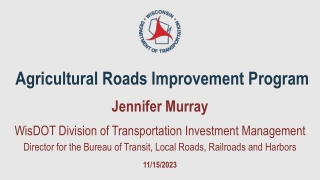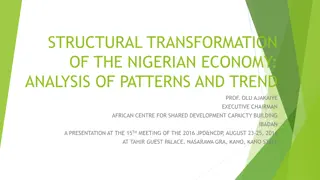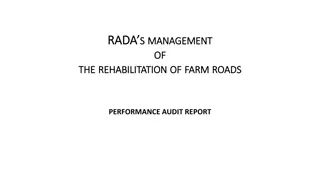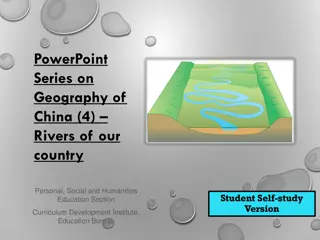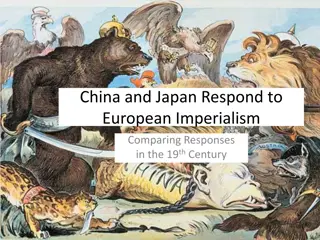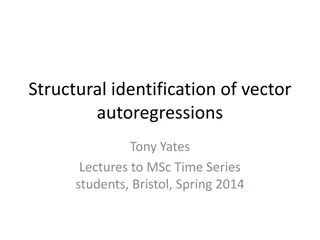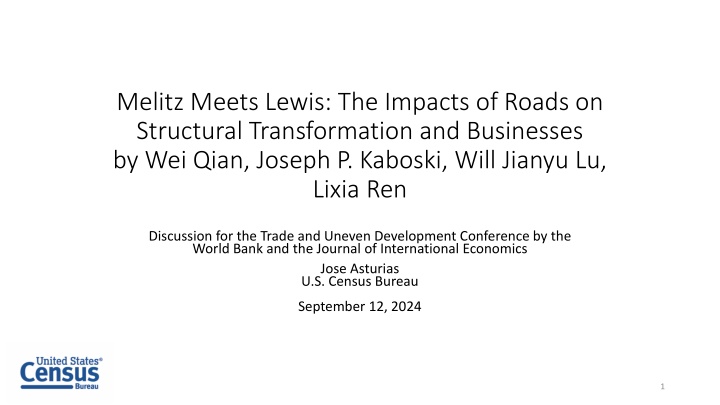
Impacts of Roads on Structural Transformation in China and India
The paper discusses the differing effects of infrastructure on the manufacturing sector in China and India based on the Melitz and Lewis models. It explores why the Melitz effect dominates in India while the Lewis effect dominates in China, suggesting a need for further empirical analysis focusing on regional heterogeneity within the countries.
Download Presentation

Please find below an Image/Link to download the presentation.
The content on the website is provided AS IS for your information and personal use only. It may not be sold, licensed, or shared on other websites without obtaining consent from the author. If you encounter any issues during the download, it is possible that the publisher has removed the file from their server.
You are allowed to download the files provided on this website for personal or commercial use, subject to the condition that they are used lawfully. All files are the property of their respective owners.
The content on the website is provided AS IS for your information and personal use only. It may not be sold, licensed, or shared on other websites without obtaining consent from the author.
E N D
Presentation Transcript
Melitz Meets Lewis: The Impacts of Roads on Structural Transformation and Businesses by Wei Qian, Joseph P. Kaboski, Will Jianyu Lu, Lixia Ren Discussion for the Trade and Uneven Development Conference by the World Bank and the Journal of International Economics Jose Asturias U.S. Census Bureau September 12, 2024 1
Disclaimer Any opinions and conclusions expressed herein are those of the author and do not reflect the views of the U.S. Census Bureau. 2
My take on the paper China and India are interesting countries to look at Large economies that have invested significantly in infrastructure Two aspects that are interesting Theoretically, they developed a model in which lowering trade costs can have differing effects on the manufacturing sector Melitz: More firm concentration (i.e., fewer firms and larger firms) Lewis: Less firm concentration (i.e., more firms and smaller firms) Simple model that yields predictions that vary based on structure of economy (i.e., the initial share of employment in agriculture) and is relevant for a development context Empirically find differing impacts of infrastructure in China and India in terms of whether the Lewis vs. Melitz effect dominate 3
Suggestion #1: What can account for the different effects in China vs. India? Would we expect the Melitz or Lewis effect to dominate in China/India? According to World Development Indicators WDI for 2000 Employment in agriculture (% of total employment) China: 50.0% India: 59.6% Employment in industry (% of total employment) China: 22.5% India: 16.3% Thus, I would have expected that both countries would behave similarly and the Lewis effect would probably dominate in both However, empirically it seems like Melitz effect dominates in India and Lewis effect dominates in China 4
Suggestion #1: What can account for the different effects in China vs. India? I think that analyzing both China and India is great, but it will be difficult for the simple model to account for the differences between these two countries Suggestion of refocusing the empirical analysis There may be heterogeneity within a country (Melitz effect dominates in some regions and Lewis in others) The strength of Lewis vs. Melitz is more of a continuum that depends on the size of the employment share in agriculture Focus the empirical analysis on the effects within a country for regions with high agricultural employment share vs. low agricultural employment share 5
Regions with larger share of employment in agricultural sector in 2000 tend to see a stronger Lewis effect as predicted by the theory Heterogeneity within country would be interesting to focus on 6
Suggestion #2: Modeling choices Currently, the model assumes that the local economy has a comparative advantage in the manufacturing goods (i.e., foreign manufactured good cannot be imported and the local agricultural good cannot be exported). We would, however, expect there to be heterogeneity in comparative advantage across regions in a country How to think about services? In India, we have that for treated areas: Number of manufacturing establishments declines (Table 1) Average employees per establishment unchanged (statistically insignificant) (Table 2) Total agricultural employment remains unchanged (statistically insignificant) (Table 3) This suggests that workers are moving towards the service sector 7
Suggestion #3: Firms in China vs. establishments in India The empirical analysis reports outcomes for firms in China and establishments in India. It would be useful to discuss how this may affect the empirical results. This may not be easy, but it would be helpful given the goal of the paper is to compare the results from China and India. 8
Conclusion Paper combines insights from trade and from the literature of structural transformation Has nice empirical work on China and India Look forward to seeing future iterations of the paper 9
Smaller suggestions (1) On page 2, have the following typo: The model we develops where the s at the end of develop is a typo. I would be careful with the following statement on page 15: our firm data for both countries are based on datasets that do not truncate coverage of small firms. You had mentioned that the coverage is for Chinese firms is for those with at least RMB5 million. 10
Smaller suggestions (2) Right now a little inconsistent with how they go back and forth using productivity as index (varphi) and the firm identity (omega). See for example, equations 4 and 5. I would suggest having language such as the following language between the definition of q_A and \ell(\varphi) on page 6: The decision of firms do not depend on their index, omega, but rather their productivity varphi. We will thus characterize the solution by indexing firms by their productivity. After that, then you can index everything by productivity. 11
Smaller suggestions (3) I am a little confused about the organization of the model section. For example, the household problem is in section called Equilibrium and Impacts of Trade Costs which seems a little odd. I would consider moving the household problem and firm problem into their own subsections of Section 2. The first sentence of the Household s Problem using notation p_N_{ROW}, which is not consistent with what is indicated in footnote 4. 12
Smaller suggestions (4) You could probably drop the following on page 8: Since locally produced agriculture is the numeraire . I do not see it being used in the second half of the sentence. In the presentation of the model, it would be helpful to define the mass of potential entrants (I do not see this defined anywhere) and the mass of entrants (M). It would also be helpful to explicitly discuss that there are zero aggregate profits in equilibrium. This is implicitly already in the model (for example, the consumer BC does not have any profits) but it would be good to make that point explicit. 13
Smaller suggestions (5) I believe that in equation 10, dphi should be dG(phi), where G(.) is the CDF of the productivities. I believe that a balanced trade condition is missing from the equilibrium description. I would consider placing the characterization of \bar{\pi} and M in a section other than the Market Clearing section. They do not really seem to be related to market clearing conditions. 14
Smaller suggestions (6) In the Chinese data, what does a mean for a firm to be in a particular region? Would it be the headquarters? I do not see equations 1 and 2 The Matsuyama paper is cited multiple times It would be interesting to expand on footnote 10 to learn more about how you construct the ratio of agricultural employment relative to the total population. Is this using the NSS? Given that you are working with Chinese data and conducting an exercise similar to Faber s ReStud paper, it may useful to discuss why it seems like you are arriving at different results (he finds that output declines in non- targeted areas). 15
Smaller suggestions (7) It is interesting to think the links between structural transformation and how the economy will behave with lower trade costs Could eventually think about a quantitative model for a future paper to further explore the topic 16
Final note For your reference, I used the version of the NBER WP, so all references like page/equation numbers would refer to that version 17

